MSN2 and MSN4 link calorie restriction and TOR to sirtuin-mediated lifespan extension in Saccharomyces cerevisiae
- PMID: 17914901
- PMCID: PMC1994990
- DOI: 10.1371/journal.pbio.0050261
MSN2 and MSN4 link calorie restriction and TOR to sirtuin-mediated lifespan extension in Saccharomyces cerevisiae
Abstract
Calorie restriction (CR) robustly extends the lifespan of numerous species. In the yeast Saccharomyces cerevisiae, CR has been proposed to extend lifespan by boosting the activity of sirtuin deacetylases, thereby suppressing the formation of toxic repetitive ribosomal DNA (rDNA) circles. An alternative theory is that CR works by suppressing the TOR (target of rapamycin) signaling pathway, which extends lifespan via mechanisms that are unknown but thought to be independent of sirtuins. Here we show that TOR inhibition extends lifespan by the same mechanism as CR: by increasing Sir2p activity and stabilizing the rDNA locus. Further, we show that rDNA stabilization and lifespan extension by both CR and TOR signaling is due to the relocalization of the transcription factors Msn2p and Msn4p from the cytoplasm to the nucleus, where they increase expression of the nicotinamidase gene PNC1. These findings suggest that TOR and sirtuins may be part of the same longevity pathway in higher organisms, and that they may promote genomic stability during aging.
Conflict of interest statement
Figures
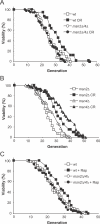
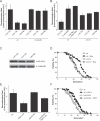

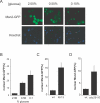
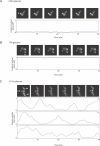


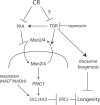
References
-
- Jiang JC, Jaruga E, Repnevskaya MV, Jazwinski SM. An intervention resembling caloric restriction prolongs life span and retards aging in yeast. FASEB J. 2000;14:2135–2137. - PubMed
-
- Barton A. Some aspects of cell division in Saccharomyces cerevisiae . J Gen Microbiol. 1950;4:84–86. - PubMed
-
- Sinclair DA, Mills K, Guarente L. Molecular mechanisms of yeast aging. Trends Biochem Sci. 1998;23:131–134. - PubMed
-
- Sinclair DA, Guarente L. Extrachromosomal rDNA circles—A cause of aging in yeast. Cell. 1997;91:1033–1042. - PubMed
-
- Guarente L. Sir2 links chromatin silencing, metabolism, and aging. Genes Dev. 2000;14:1021–1026. - PubMed
Publication types
MeSH terms
Substances
Grants and funding
LinkOut - more resources
Full Text Sources
Other Literature Sources
Molecular Biology Databases

